
Woodworking is the skill of making items from wood, and includes cabinetry, furniture making, wood carving, joinery, carpentry, and woodturning.
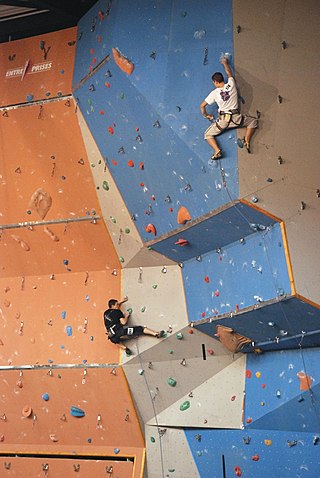
A climbing wall is an artificially constructed wall with manufactured grips for the hands and feet. Most walls are located indoors, and climbing on such walls is often termed indoor climbing. Some walls are brick or wooden constructions but on modern walls, the material most often used is a thick multiplex board with holes drilled into it. Recently, manufactured steel and aluminum have also been used. The wall may have places to attach belay ropes, but may also be used to practice lead climbing or bouldering.

A banner can be a flag or another piece of cloth bearing a symbol, logo, slogan or another message. A flag whose design is the same as the shield in a coat of arms is called a banner of arms. Also, a bar-shaped piece of non-cloth advertising material sporting a name, slogan, or other marketing message is also a banner.

The Mogao Caves, also known as the Thousand Buddha Grottoes or Caves of the Thousand Buddhas, form a system of 500 temples 25 km (16 mi) southeast of the center of Dunhuang, an oasis located at a religious and cultural crossroads on the Silk Road, in Gansu province, China. The caves may also be known as the Dunhuang Caves; however, this term is also used as a collective term to include other Buddhist cave sites in and around the Dunhuang area, such as the Western Thousand Buddha Caves, Eastern Thousand Buddha Caves, Yulin Caves, and Five Temple Caves. The caves contain some of the finest examples of Buddhist art spanning a period of 1,000 years.
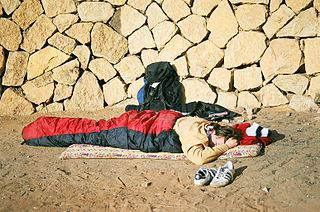
A sleeping bag is an insulated covering for a person, essentially a lightweight quilt that can be closed with a zipper or similar means to form a tube, which functions as lightweight, portable bedding in situations where a person is sleeping outdoors. It is also commonly used indoors for people who do not have beds or at sleepovers. Its primary purpose is to provide warmth and thermal insulation through its synthetic or down insulation. It also typically has a water-resistant or water-repellent cover that protects, to some extent, against wind chill and light precipitation, but a tent is usually used in addition to a sleeping bag, as it performs those functions better. The bottom surface also provides some cushioning, but a sleeping pad or camp cot is usually used in addition to that purpose. The bottom surface of a sleeping bag may be moderately water repellent, but a plastic tarp or groundsheet is often used to protect against moist ground.
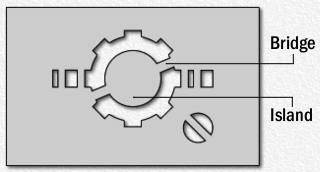
Stencilling produces an image or pattern on a surface by applying pigment to a surface through an intermediate object, with designed holes in the intermediate object. The holes allow the pigment to reach only some parts of the surface creating the design. The stencil is both the resulting image or pattern and the intermediate object; the context in which stencil is used makes clear which meaning is intended. In practice, the (object) stencil is usually a thin sheet of material, such as paper, plastic, wood or metal, with letters or a design cut from it, used to produce the letters or design on an underlying surface by applying pigment through the cut-out holes in the material.

A go-kart, also written as go-cart, is a type of small sports car, close wheeled car, open-wheel car or quadracycle. Go-karts come in all shapes and forms, from non-motorised models to high-performance racing karts. Karting is a type of racing in which a compact four-wheel unit called a go-kart is used. Art Ingels created the first go-kart in Los Angeles in 1956.

A thangka is a Tibetan Buddhist painting on cotton, silk appliqué, usually depicting a Buddhist deity, scene, or mandala. Thangkas are traditionally kept unframed and rolled up when not on display, mounted on a textile backing somewhat in the style of Chinese scroll paintings, with a further silk cover on the front. So treated, thangkas can last a long time, but because of their delicate nature, they have to be kept in dry places where moisture will not affect the quality of the silk. Most thangkas are relatively small, comparable in size to a Western half-length portrait, but some are extremely large, several metres in each dimension; these were designed to be displayed, typically for very brief periods on a monastery wall, as part of religious festivals. Most thangkas were intended for personal meditation or instruction of monastic students. They often have elaborate compositions including many very small figures. A central deity is often surrounded by other identified figures in a symmetrical composition. Narrative scenes are less common, but do appear.

The Sydney Trades Hall, also known as the Trades Hall Building and the Trade Unions Hall, is a heritage-listed trade union building located at 4-10 Goulburn Street in the Sydney central business district, in the City of Sydney local government area of New South Wales, Australia. It was designed by John Smedley, with later additions by Spain and Cosh and Minnett, and was developed from 1888 to 1916. The building was built and owned by the Trades Hall Association, the original trade union affiliates who built the hall in 1888, and is now owned by Unions NSW. The property was added to the New South Wales State Heritage Register on 2 April 1999.

Cultivation of cannabis is the production of cannabis infructescences. Cultivation techniques for other purposes differ.

The Durham Miners' Gala is a large annual gathering and labour festival held on the second Saturday in July in the city of Durham, England. It is associated with the coal mining heritage of the Durham Coalfield, which stretched throughout the traditional County of Durham. It is also locally called "The Big Meeting" or "Durham Big Meeting". In the context of the Durham Miners' Gala, "gala" is usually pronounced rather than the more common pronunciation.
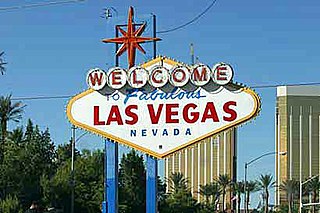
Signage is the design or use of signs and symbols to communicate a message. Signage also means signs collectively or being considered as a group. The term signage is documented to have been popularized in 1975 to 1980.
The study of the history of clothing and textiles traces the development, use, and availability of clothing and textiles over human history. Clothing and textiles reflect the materials and technologies available in different civilizations at different times. The variety and distribution of clothing and textiles within a society reveal social customs and culture.
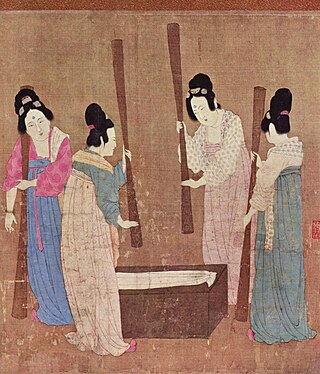
The production of silk originated in Neolithic China within the Yangshao culture. Though it would later reach other places in the world, the art of silk production remained confined to China until the Silk Road opened at 114 BC. Even after trade opened, China maintained a virtual monopoly over silk production for another thousand years. The use of silk within China was not confined to clothing alone, and silk was used for a number of applications, such as writing. Within clothing, the color of silk worn also held social importance, and formed an important guide of social class during the Tang dynasty of China.
Banners are a significant part of the Culture of Northern Ireland, particularly for the Protestant/unionist community, and one of the region's most prominent types of folk art. They are typically carried in parades such as those held on the Twelfth of July, Saint Patrick's Day and other times throughout the year. Generally these are organised by societies such as the Orange Order, the Ancient Order of Hibernians, the Royal Black Institution and the Apprentice Boys of Derry, and the banners are typically commissioned by, and represent, a lodge within one of these societies. Banners are also carried by trade unions and church groups, and by marching bands. Most banners are painted by professionals and executed on silk, although canvas was a more popular material in the past. Most have a painting on each side, usually depicting different subjects, and the name and number of the lodge. Most banners have one subject per side, surrounded by flourishes, scrolls, and other decoration. Despite being in many ways a sectarian art form, Catholic and Protestant banners are usually very similar in terms of style and composition. Apart from subject matter, the main difference is colour: Orange Order banners make heavy use of the colour orange and to a lesser extent red, white, blue and purple, while Catholic banners tend to feature a lot of green.
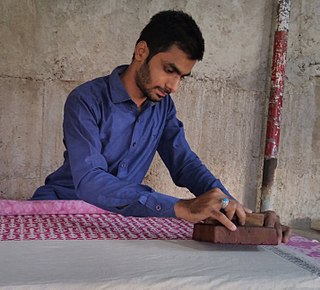
Woodblock printing on textiles is the process of printing patterns on fabrics, typically linen, cotton, or silk, by means of carved wooden blocks.
A speed skating rink is an ice rink in which a speed skating competition is held.

The national flag of Ireland, frequently referred to in Ireland as 'the tricolour' and elsewhere as the Irish tricolour, is a vertical tricolour of green, white and orange. The proportions of the flag are 1:2.
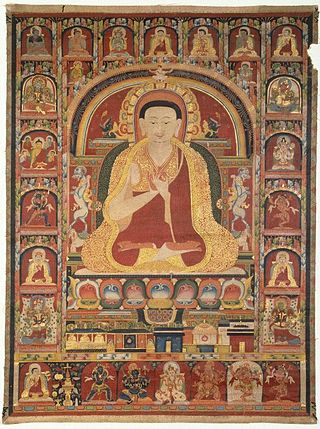
The conservation and restoration of Tibetan thangkas is the physical preservation of the traditional religious Tibetan painting form known as a thangka. When applied to thangkas of significant cultural heritage, this activity is generally undertaken by a conservator-restorer.

The conservation and restoration of totem poles is a relatively new topic in the field of art conservation. Those who are custodians of totem poles include Native American communities, museums, cultural heritage centers, parks or national parks, camp grounds or those that belong to individuals. Conservation activities include the historical research and context of totem poles, studying materials and manufacture, performing assessments, documentation and treatments. This field can pertain to conservator-restorers, Native Americans, curators, collection managers, registrars, park rangers and city planners.



















